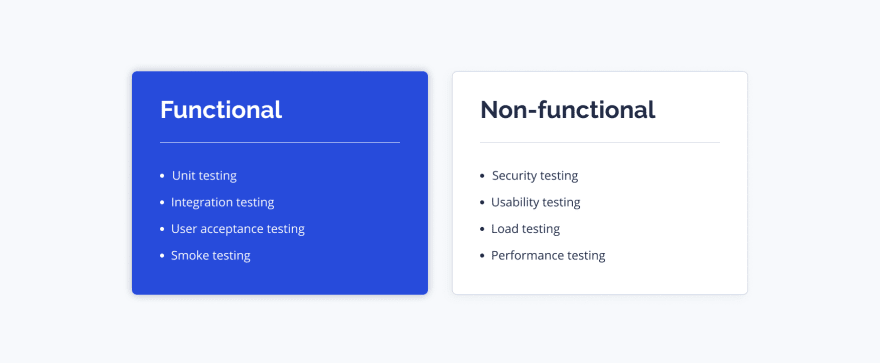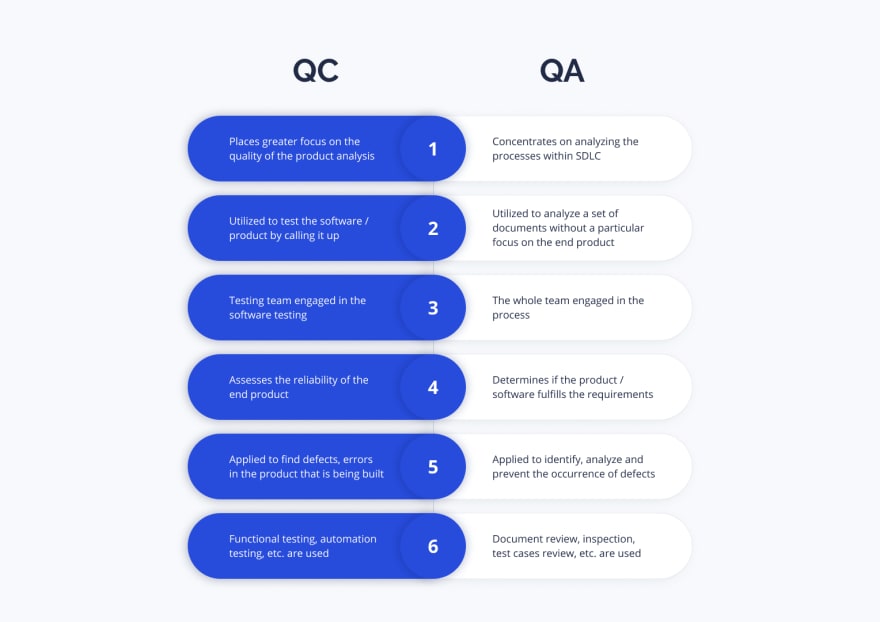In this article, we have collected and focused all our expertise to help you with the most useful questions and answers that will be helpful for you in a manual testing interview in 2021. Let's get started!
1. What does the test strategy include?
This test strategy goal is to show customers all the activities and tools from the manual testing team for the project quality assurance. It should include the following points:
- Resource;
- Scope and timetable for test activities;
- Testing tools;
- Testing priorities;
- Test plan;
- Testing types.
2. What is the goal of ad-hoc testing?
Ad-hoc testing helps engineers to break the system without sticking to the pre-specified test cases. The goal is to find some issues that are not specified in requirements or test cases but could be faced by users in their critical path of usage.
3. What testing types are more important?
Here are the required testing types for having good quality and assure its maintenance:
- Unit testing;
- Integration testing;
- Systems testing;
- Functional testing;
- Non-functional testing;
- Regression testing;
- Sanity testing;
- Ad-Hoc testing;
- Smoke testing;
- Acceptance testing;
- Alpha testing;
- Beta Testing.
4. What is the difference between functional and non-functional testing?
Functional testing is more about the verification of functionalities' expected behavior. Commonly, functionality testing is about black-box testing. A tester doesn't need the code to check how functionalities are working. Non-functional testing is about checking non-functional items like performance, security, or usability of the application.
5. Have you had experience writing test cases without project requirements?
The interviewer asks this question to understand how you can handle the kind of projects without any requirements. So, the best answer for this question is to share options on how you handled it:
- I tried to contact a Project manager/Product owner and ask questions about how this specific functionality should work.
- The second option is to do refinement meetings to refine requirements together with the whole team.
- The third option is to ask for BA for requirements and give highlights on why it is important.
- To implement Definitions of Ready for user stories before including tasks into the Sprint.
6. Can you please give examples where it is important to provide the Regression testing?
Here are the most important reasons why we should provide regression testing:
- Bug fixes that could break working functionality;
- Big updates in a system;
- New functionalities;
- Extended testing before release.
7. What is Acceptance testing, and when should you provide it?
Acceptance testing evaluates if the application complies with the business requirements. Also, we use it to make sure the build is ready for presentation. As a rule, we provide acceptance testing at the end of a Sprint, just before delivering it to the customers. There is also the UAT (User Acceptance Testing) testing type. End-users or customers provide this type of manual testing to ensure that new functionalities meet the business requirements.
8. How important is it for QA to take part in development planning sessions?
The importance of planning for QA is that QA engineers can estimate and plan their tasks during the Sprint. They can extrapolate the risks related to old functionalities to the new ones. Give recommendations and plan the quality control by keeping in mind the new development plan. The most important thing here is the risk management based on picked user stories. It's all about quality.
9. At what stage of the project should QA activities start?
The QA activities should start as early as possible. Ideally, it should accompany the development process from the very beginning. QA, here, helps avoid the risks connected to the quality. Thus, the team has more time to create a structured Test Plan and strategy to follow.
If QA activities start later, it can cost a lot of money to fix all the bugs. Besides, most users can stop using the application because of the inconsistent performance.
Otherwise, you'll need to postpone the release date to initiate an additional testing routine. Nevertheless, broken deadlines will also harm the product's reputation.
10. When is it required/recommended to automate the QA process?
Usually, you automate QA processes for a stable build. Additionally, you can use it to make manual QA work easier while regression testing needs to be done.
How will automation help with regression testing? When QA deals with new functionality, you can run automated tests. It will help to make sure that the existing functionalities' critical path works.
There are good practices that don't allow the delivery of a build while all automated tests are not passed. Otherwise, the occurred issues should be fixed before delivery.
Automation is also good to run for a Production environment. To ensure that while users deal with software applications, there are no critical issues. If there are, the team will have the ability to fix them as soon as possible.
11. What is QA and QC?
This is a confusing question for the QA engineers, but the most popular one during interviews. Let's start with quality assurance: QA specialists ensure quality for the product by process improvements, applying different approaches for the testing team and the whole team to improve the work and project quality.
Quality Control (QC) is about providing testing approaches to understand that the application meets all the requirements and has no critical issues.
In general, QA is a high-level activity that controls and applies everything to improve the software quality.
12. What must-have "Definition of Readies" would you add for a project?
Definition of Ready should help a team to have finalized user stories with all crucial information and business requirements.
An example of common DoR could be the following:
- User story dependencies are defined;
- User story requirements defined;
- User story acceptance criteria are defined;
- User story can be divided into sub-tasks;
- The Sprint backlog is prioritized;
- The team has the same vision of new functionality.
13. What is the difference between Sanity testing and Smoke testing?
Mixing up the Sanity testing with Smoke testing is the common mistake testers make.
First of all, I'd like to draw your attention to the fact that Sanity testing is a higher level of regression testing. The regression testing focuses only on details and has a deep dive into every functionality, whereas Sanity testing is focused on critical parts of functionalities.
Sanity testing is the best option when there is no time for full regression testing.
14. Can you explain the difference between retesting and regression testing?
We make retesting to check if we've removed and fixed all the bugs from the software. In contrast, regression testing is about ensuring that every fix or update hasn't impacted working functionality negatively.
15. You have a two-week Sprint. Every two Sprints, the project goes to Production. How do you manage testing activities to assure quality?
You can access questions 15-32 on Akveo official website
32. What does Quality mean?
In the context of QA, the quality application means that it is error-free, meets all customer’s needs and requirements. The great product quality will result in customer satisfaction. So, you can measure your app’s quality by the level of customer loyalty.
The most important traits of a high-quality application are:
- Security: users can trust their personal data to us and feel safe about it;
- Performance: This is a crucial parameter for any application. Especially when the app uses the Internet or handles huge amounts of data. Top applications should demonstrate exceptional offline persistence and storage capacity;
- User-friendliness: A great application always has an intuitive and easy-to-use interface. This aspect has a decisive impact on the user experience.
33. What is end-to-end testing?
End-to-end testing is about testing the application from start to end. Testing includes the end-user use cases. End-to-end testing is about checking the application's business logic.
In End-to-end testing, the application is being checked with all its dependencies and integrations: databases, 3rd party system, file system, etc.
34. What will you do if the Dev team doesn't agree with your corrections?
The answer depends on the situation and team. There are a bunch of resolution options. Firstly, a QA engineer could relate to the requirements if there are some. If it is a non-functional bug, it is important to explain to a developer that it will affect user satisfaction. If the issue remains, then they can ask BA for help. Here, the bug importance also makes sense. You can skip some bugs when they don't affect user experience, functionality, etc.
35. Why does the project need unit tests if there are QA engineers in the team?
Quality starts from the code. So, it is essential to test a code before having functionality for users.
This is about bug costs. The critical bugs could cost more resources. So, it is important to have the right approach to quality, starting from the application code.
36. Why should Smoke testing be stopped when we face a blocker issue?
The Smoke test is about checking the most important parts of the functionality. If you find them blocked, it doesn't make sense to provide further testing. It is critical to fix all the blocker issues before the beginning of the extended testing.
37. Can you recollect your biggest manual testing failure, and what lessons did you learn from it?
It is important to give some examples of the failures you had in your QA career. The interviewer would want to know your attitude toward making mistakes. Every good specialist has had some failures that have brought much work experience. Such experience adds much value to your expertise.
For instance, speak about a bug or two you once missed on Production, or it could be something about your team or communication with customers.
38. What is the effective way to manage and support the non-reproducible bugs?
To handle the non-reproducible bugs, you can do the following:
- Add execute test-cases which include the bug’s steps to be sure that during every execution, the case is passed or the bug could be caught somehow;
- To summarize and evaluate the test execution results for this particular check;
- To look into application/user logs to give more information when the bug reproduces.
39. When do you start testing the design of new functionality?
To start the manual testing, you should understand how the QA engineer organizes their entry documents.
Thus, you need to start the test design once the functionality requirements are finalized. While the functionality is developing, a tester could start test design to be ready for test execution right away after the functionality implementation. After the first execution, you can update them and improve.
The main goal is to provide enough testing for new functionality and not to miss any bugs. That's why it is recommended to prepare test cases in advance.
40. What is Bug triage, and why does the team need it?
Bug triage is a process of prioritizing bugs in Sprint. The prioritizing is based on bugs' impact on the application's quality and business logic. It helps the team to fix more important issues first and do the stabilization part in a very efficient way.









Top comments (0)